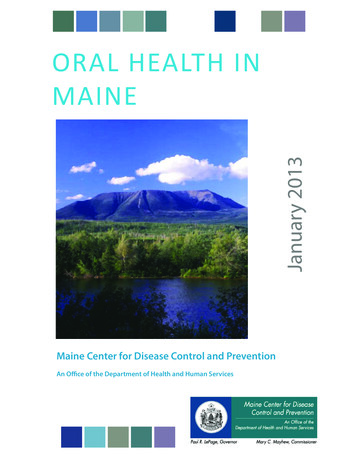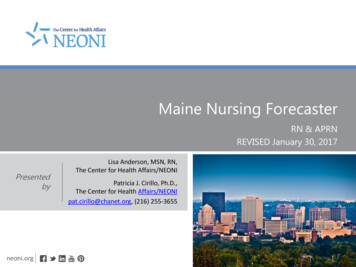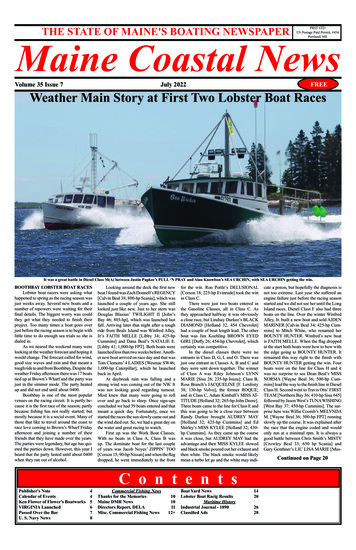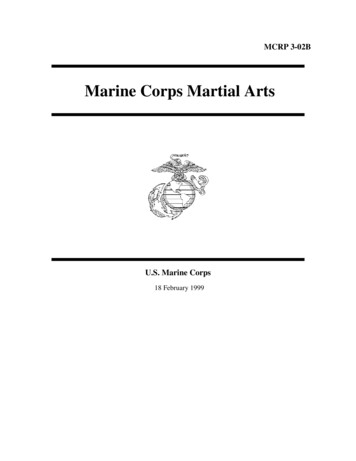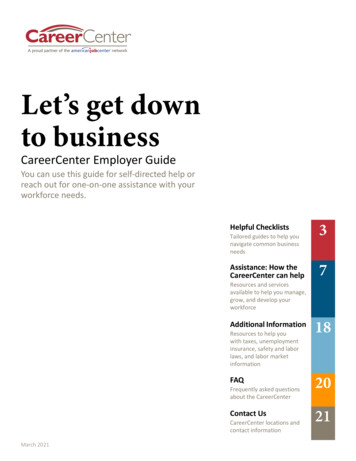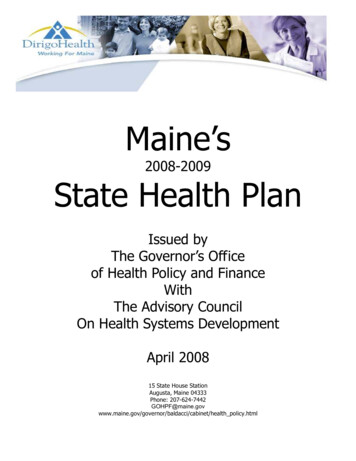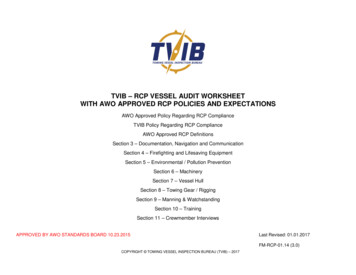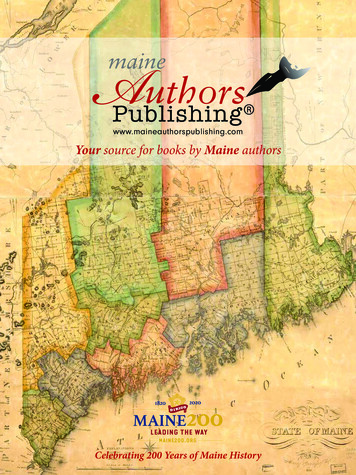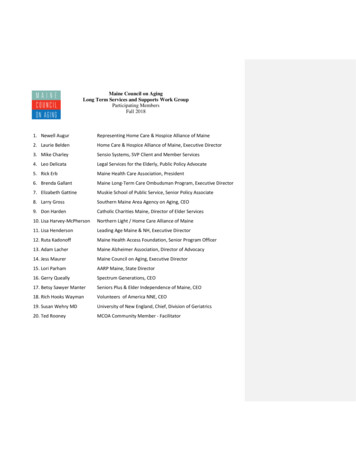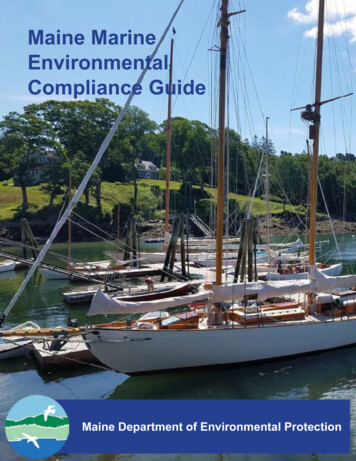
Transcription
Maine MarineEnvironmentalCompliance GuideMaine Department of Environmental Protection
Maine Marine Environmental Compliance GuideContentsIntroduction 5Machine Shop and WeldingManual Guide and Use5Definitions 6Environmental Management 11Facility ChangesFueling59Storage60Cleaning and Solvent Use 61Hauling and Storing Boats11Waste Regulations 15Hazardous Waste Management 15Universal Waste Management 215863Mechanical, Equipment Operations,and Storage 65Additional Resources 67Air Compliance Tool67Hazardous Waste Table77Solid and Special WasteInspection Checklist for HazardousRegulations Waste Container27Storage Areas79Fueling, Storage and Spill PreventionUniversal Waste Notification FormRegulations 2880Stormwater Management GeneralWeekly Checklist for Universal WastePermit29Storage Areas81Air Regulations30Industrial Stormwater (MSGP) 82Operational Guidance 51Solvent Wipes Table84Abrasive Blasting 53SPCC Plan Template86Fiberglassing: Full Construction andRepair54SWPPP Plan Template106Painting55Carpentry and Woodworking57Hazardous Waste Contingency PlanDeficiency List135How to Maintain or Rebuild EnginesCertified to EPA Standards139Maine Department of Environmental Protection
4
IntroductionThis handbook is designed to help small and large boatyards and marinas maintain compliance withenvironmental regulations in Maine. It can be used as a planning tool, for reference, or as a trainingtool for facility staff. By working together to operate clean and safe marinas, we can protect theair, land, and water that makes Maine unique, as well as protect the health of marina workers andvisitors.Manual Guide and UseThere are 3 sections in this manual:1. “Environmental Management”– applicablestatutes and rules for management2. “Operational Guidance” – environmentalcompliance fact sheets for each activity3. “Additional Resources” – useful tools andregulatory guidanceSection 1 “Environmental Management” isa listing and explanation of the environmentalregulations the marine industry will likelyneed to follow. This section was developed toassist management and environmental staffwith applicable regulations and requirementsgoverning the activities at the marine facility.This section is broken down by media includingHazardous Waste, Stormwater, Air, and Land/Natural Resources. In addition, facility changesincluding production increase, introduction of newproduction technologies, and facility expansionsare addressed which may require modifingregulatory practices and obtaining additionalpermits.Documentation serves multiple purposesincluding: identification of regulatory thresholdsthat could be triggered, permit applicability,identification of financial and material wastes/losses, and inspection/audit transparency thatwill save time and money. Documentationserves as a multi-beneficial tool that can reduceregulatory burden and liability.Section 2 “Operational Guidance” containsenvironmental compliance fact sheets for eachactivity boat builders and marinas would likelybe undertaking including fiberglassing, painting,metal fabrication, abrasive blasting, painting,engine work/fueling, repairing, and cleaning. Thefact sheets reference the applicable regulationsalong with environmental control measuresto guide employees to perform their work incompliance with environmental regulations.Section 3 “Additional Resources” containshelpful tools to assist the marine industry indetermining regulatory thresholds and applicablecompliance.The most important piece is to DOCUMENTall materials used in the Facility’s processesand document all waste and emissions.rev. 20195Maine Department of Environmental Protection
DefinitionsVolatile Organic Compounds (VOC)Any compound of carbon, excluding carbonmonoxide, carbon dioxide, carbonic acid,metallic carbides or carbonates, andammonium carbonate, which participates inatmospheric photochemical reactions (i.e., ispart of the reaction that creates ground-levelozone).This definition excludes organic compoundswhich EPA has determined to have negligiblephotochemical reactivity as listed in 40 C.F.R.Part 51.100(s)(1) as amended up to July 1,2015.Monomer VOCA relatively low-molecular-weight organiccompound such as styrene that combineswith itself, or other similar compounds, bya cross-linking reaction to become a curedthermosetting resin. Monomer VOC arelimited in Maine’s rule 06-096 C.M.R. ch. 162in the same ways as organic HAP are in 40C.F.R. Part 63, Subpart VVVV.Hazardous Air Pollutants (HAP)An air pollutant to which no ambient air qualitystandard is applicable causes or contributesto air pollution which may reasonably beanticipated to result in an increase in mortalityor an increase in serious irreversible, orincapacitating reversible, illness. This termshall include, but is not limited to, thosepollutants for which EPA has adoptedNESHAPS at 40 C.F.R. Parts 61 and Part 63.For the purpose of Chapters 115 and 140 (AirEmission Licensing rules), HAP means an airpollutant identified by the EPA in regulationspursuant to Section 112(b) of the Clean AirAct.Introduction6A list of HAP can be found on EPA’shazardous air pollutants webpage irpollutants-modifications)Organic HAPAny HAP that contains carbon. Forboatbuilding operations, these typicallyare styrene, methyl methacrylate (MMA),methylene chloride (dichloromethane),toluene, xylene, n-hexane, methyl ethylketone (MEK), methyl isobutyl ketone(MIBK), and methyl chloroform (1,1,1 –trichloroethane) according to the Summarysection of the preamble for 40 C.F.R. Part 63,Subpart VVVV.According to Section IV(H) of the preamblefor 40 C.F.R. Part 63, Subpart VVVV, EPAconcludes that inorganic HAP are added aspigments to gel coats and surface coatingsand are not emitted from the operationsregulated by these NESHAP and, therefore,are not included in determining HAP content.Single HAPUnlike all other pollutants, HAP are accountedfor and limited in a group (like volatile organiccompounds) and as individual pollutants (likecarbon monoxide).EPA Method 9A test method for visible determination ofthe opacity (as defined) of emissions fromstationary sources. Emissions are measuredin % opacity and certifications can beobtained through locally-offered courses.More information about EPA Method 9 canbe found at EPA’s Method 9 - Visual Opacitywebpage (https://www.epa.gov/emc/method9-visual-opacity)
Opacity (as in % opacity)The degree of light obscuring capabilityof emissions of visible air contaminantsexpressed as a percentage. For example,complete obscuration shall be expressed as100% opacity.Aluminum Wipedown SolventsAccording to 40 C.F.R. Part 63, SubpartVVVV, Aluminum Wipedown Solvents aresolvents used to remove oil, grease, weldingsmoke, or other contaminants from thealuminum surfaces of a boat before primingor painting. Aluminum wipedown solventscontain no coating solids. Aluminum surfacepreparation materials that contain coatingsolids are considered coatings for the purposeof Subpart VVVV and are not wipedownsolvents.Federal and Maine state accounting forpotential to emit are different. Federalstandards require that EPA account forpotential to emit as the maximum potential,while Maine’s standards require that itaccount for potential to emit using normaloperations. Therefore, a facility that isconsidered a minor source by the state ofMaine may be considered a major source byEPA if it does not have federally enforceablelimits (usually from an air emission license) onpollutants such as VOC or HAP.Major Source (or Major HAP source)Insignificant ActivityAn insignificant activity is a change made ata facility that is defined by the Department inAppendix B of Chapter 140 and in AppendixB of Chapter 115. A source must includeemissions from insignificant activities indetermining if the facility is a major source.Minor SourceA facility with the potential to emit less thanthe following: 50 tons per year VOC 10 tons per year of a single Hazardous AirPollutant 25 tons per year of all Hazardous AirPollutants combined 100 tons per year of any other regulatedpollutantFacilities that have the potential to emit belowthe threshold levels of VOC or other regulatedrev. 2019pollutants are considered Minor Sources ofCriteria Air Pollutants (CAP). Facilities thathave the potential to emit below the thresholdlevels of HAP are considered Area Sources ofHAP. A source may be a minor or area sourceof one pollutant and a major source (asdefined) of another.7A facility with the potential to emit more thanthe following: 50 tons per year VOC 10 tons per year of single Hazardous AirPollutant 25 tons per year of all Hazardous AirPollutants combined 100 tons per year of any other regulatedpollutantBecause CAP and HAP are accounted fordifferently, as discussed in the definitionfor Minor Source, a facility may be a minor/area source for one and a major source foranother.Federal and Maine state accounting forpotential to emit are different. Federalstandards require that EPA account forpotential to emit as the maximum potential,while Maine’s standards require that itMaine Department of Environmental Protection
account for potential to emit using normaloperations. Therefore, a facility that isconsidered a minor source by the state ofMaine may be considered a major source byEPA if it does not have federally enforceablelimits (usually from an air emission license) onpollutants such as VOC or HAP.Ground-level (Tropospheric) OzoneOzone that is in the Troposphere and can beinhaled by humans. This is most commonlyknown as ground-level ozone.EPA Ground level ozone pollution lled Spraying TechniquesTechniques used to increase spray efficiencyand reduce VOC and HAP emissions.Information about controlled sprayingeducation can be found online and throughindustry associations.12 Month Rolling TotalThe cumulative total of whatever is beingcounted over the last 12-months, updatedeach month.Hot Water HeaterEPA defines a hot water heater as thefollowing in 40 C.F.R. Part 63, SubpartsJJJJJJ and DDDDD:Hot water heater means a closed vessel witha capacity of no more than 120 U.S. gallonsin which water is heated by combustion ofgaseous, liquid, or biomass/bio-based solidfuel and is withdrawn for use external to thevessel. Hot water boilers (i.e., not generatingsteam) combusting gaseous, liquid, orbiomass fuel with a heat input capacity of lessthan 1.6 million Btu per hour are included inthis definition. The 120 U.S. gallon capacitythreshold to be considered a hot water heaterIntroduction8is independent of the 1.6 MMBtu/hr heat inputcapacity threshold for hot water boilers. Hotwater heater also means a tankless unit thatprovides on demand hot water.Reconstruction/ Reconstructed Engine(stationary)Reconstruction is defined by EPA in Parts60 and 63 in the following way:Reconstruction, unless otherwise defined ina relevant standard, means the replacementof components of an affected or a previouslynonaffected source to such an extent that: The fixed capital cost of the newcomponents exceeds 50 percent of thefixed capital cost that would be requiredto construct a comparable new source;and It is technologically and economicallyfeasible for the reconstructed sourceto meet the relevant standard(s)established by the Administrator (or aState) pursuant to section 112 of the Act.Upon reconstruction, an affected source,or a stationary source that becomes anaffected source, is subject to relevantstandards for new sources, includingcompliance dates, irrespective of anychange in emissions of hazardous airpollutants from that source.40 C.F.R. Part 60, Subpart III definesReconstructed Engine in the following way:Reconstructed engines are assigned a newdate of manufacture if the fixed capital costof the new and refurbished componentsexceeds 75 percent of the fixed capital costof a comparable entirely new facility. Anengine that is produced from a previouslyused engine block does not retain the date ofmanufacture of the engine in which the engineblock was previously used if the engine is
SWPPP – Stormwater Pollution PreventionPlanproduced using all new components exceptfor the engine block. In these cases, the dateof manufacture is the date of reconstructionor the date the new engine is produced.A SWPPP is a required plan that must bedeveloped in accordance with Maine DEP’sMulti-Sector General Permit - StormwaterDischarge Associated with Industrial Activity.Engine Rebuild (marine engines)From 40 C.F.R. § 1068.120(b):Hazardous WasteThe term rebuilding refers to work done onan engine or engine system to significantlyincrease its service life. It also includesreplacing or rebuilding an engine'sturbocharger, aftercooler, or systems for fuelmetering or electronic control. For theseprovisions, rebuilding may or may not involveremoving the engine from the equipment.Rebuilding does not normally include thefollowing: Scheduled emission-relatedmaintenance that the standard-settingpart allows during the useful life period(such as replacing fuel injectors). Unscheduled maintenance that occurscommonly within the useful life period.For example, replacing a water pump isnot rebuilding an engine.rev. 2019Waste that either exhibits a hazardouscharacteristic, or because it is a listed waste.Acute Hazardous WasteOne of the five categories of listed wastedue to it’s extreme hazardous nature.9Maine Department of Environmental Protection
10
Environmental ManagementThis document has been developed by the Maine Department of Environmental Protection(Department) as a reference document for facility managers at boat building facilities in the Stateof Maine. All procedures, policies, and regulations are current as of its writing. From time to time,the Department may update or amend these documents. For the most up to-date information,please visit the Maine Secretary of State Rule Chapters for the Department of EnvironmentalProtection. Please ensure your production employees are aware of all applicable regulatorycontrol measures they need to follow and provide them with the specific information located in the“Operational Guidance” section.Facility ChangesChanges at the facility can trigger differentregulatory thresholds depending on the activity.Thresholds include industrial stormwaterpollution prevention modifications, land permits,air permits, hazardous waste categories, andmanagement requirements:with DEP Land staff before doing the work isstrongly advised. Contact the Department prior toundertaking the following activities to ensure youare in compliance including permit applicability: Pier construction or renovation – addingor replacing pilings, adding or replacing fillunder a pierThe facility’s SWPPP must be updated within30 days of completing a change in design,construction, operations, or maintenance thatmay have a significant effect on the dischargeor potential for discharge of pollutants from thefacility. Seawalls or bulkheads – adding, replacing,expanding a structure Boat ramp construction or upgrade Marine lift installation, upgrade orreplacementLand Permitting Shoreline stabilization with riprap and/orvegetation Dredging Installation of new floats or slips (newmoorings by themselves are generallyexempt) Building construction, expansion, grading,or paving within the 75-foot setback Drainage work within the 75-foot setbackIndustrial StormwaterUnder the Natural Resources Protection Act(NRPA), the Department has jurisdiction overactivities in and adjacent to coastal wetlands(38 MRS §§480-A et seq). Adjacent generallymeans within 75 feet of the Highest Annual Tide(HAT) line. Please check with the Departmentregional office staff before doing any work insubtidal or intertidal area, or landward withinthe 75-foot setback from the HAT, to determineif a NRPA permit is required. (www.maine.gov/dep/land) Many maintenance activities mayqualify as exempt from permitting, but checkingrev. 201911Maine Department of Environmental Protection
Other related approvals that may be requiredinclude: Submerged Lands Lease - Department ofAgriculture, Conservation and Forestry,Bureau of Parks and Lands nds.shtml)pollutant;Most Boatyards that require a license meet theapplicability threshold for either 100 lb/day or 10lb/hr of VOC or HAP.Here are examples of some activities that mightresult in either of those emissions levels: Spraying approximately 4.5 gallons ofgelcoat (43% styrene with a density of9 lb/gal) in an hour (approximately 270square foot hull); Spraying approximately 45 gallons of theabove gelcoat in one day; Using 3 gallons of paint/primer/varnish/etc. (400 g/L of VOC) in one hour;Air Licensing A. If you do not currently have an AirEmissions License:Using 30 gallons of paint/primer/varnish/etc. (400 g/L of VOC) in one day; or A combination of the above Local Shoreland Zoning approval – checkwith your town’s code enforcement officer U.S. Army Corps of Engineers gulatory.aspx) Harbormaster approvalConsidering all of the following: Internal combustion units (engines/generators) rated higher than0.5 MMBtu/hr Other fuel-burning units rated higher than1 MMBtu/hr VOC and/or HAP emission sourcesApplicability calculations can be complex forVOC and HAP emissions, so please do at leastof the following to check if you need a license:1. Visit Maine Air Bureau’s licensing website(https://www.maine.gov/dep/air/permits/)and fill out the compliance tools for boatbuilders and service yards. This shouldgive you an estimate of whether or notyou meet the applicability threshold;If the source meets any of the following, itis required to have a Maine Air EmissionsLicense: 10.0 MMBtu/hr or more of total fuelburning units; 5.0 MMBtu/hr or more of total internalcombustion engines; 100 lb/day emissions of any regulatedpollutant; 10 lb/hr emissions of any regulatedFacility Changes2. Contact the Department’s Air Quality’sLicensing section for assistance withcalculations and emissions estimates orto set up a compliance assistance visit;or3. Contact the Department’s SmallBusiness Technical Assistance Program.This group is designed to assist withtechnical questions from the regulatedcommunity and is not directly affiliatedwith the Air Licensing section.12
In addition to checking on applicability, it isimportant that both large or small boat yardsmaintain order records of all VOC and/orHAP containing materials as suggested inthe “Cleaning and Solvent Use” section ofthis manual. Keeping these records will resultin a simpler federal or state inspection andmore accurate and conservative emissionsestimates.accounting processB. Facilities with a current Minor SourceAir Emissions License: Process change that reduces VOC and/or HAP emissions Addition of a parts washer Addition of a spray booth Addition of a building to produce boats,but with no licensed emission change3. Application and ProcessAny change to the facility that goes against acondition in the license or that may result inan increase of emissions requires a revisionor modification to the license unless thechange is insignificant (see “Definitions”).License amendments have no applicationfee and they need to be issued prior to anychange. The different categories that wouldresult in changes to minor source licensesare: Must be applied for prior to beginningproject Less information required than formodifications No public notice required No minimum amount of time unit licenseis issued Application submitted according to theapplication instructions on the Bureauof Air Quality’s Minor Source r.html)Minor Revision1. Qualifications Physical changes that effect air pollutionbut that do not effect licensed emissions; Nonphysical changes that do not effectlicensed emissions; or Nonphysical changes that increaselicensed emissions by less than 4 tons/year for any one regulated pollutantexcept greenhouse gasses and by lessthan 8 tons/year total for all regulatedpollutants, except for greenhousegasses.2. Examples Fuel switch from distillate fuel to naturalgas in boilers or engines Adjustment to VOC and/or HAPrev. 2019Minor Modification1. Qualifications Physical change that increases thelicensed emissions of any regulatedpollutant; or Nonphysical change that increaseslicensed emissions by more than theminor revision levels.Either of those two must also meet thefollowing: Physical or nonphysical change thatdoes not make a minor source a majorsource (see “Definitions”).2. Examples13Maine Department of Environmental Protection
Installation of a new fuel burning unit(boiler, generator, oven, make up airunit, waste oil furnace, etc.) rated aboveminimum licensing thresholds (see“Potentially Applicable Regulations”).2. Application and Process Contact the Bureau of Air Quality’slicensing section to discuss project aslong before the beginning of the projectas possible The addition of a new production buildingthat requires the VOC or HAP emissionlimit to be increased. The addition of spray guns that requirethe VOC or HAP emission limit to beincreasedLonger and more complicated processthan those of both Minor Revisions andMinor Modifications Must be applied for prior to beginningproject Ability to make more boats (moreemployees, large contract, increasedsales) which requires an emission limitincrease of 4 tons/year or more of VOC. Public notice required License cannot be issued prior to the endof the public comment period (21 daysafter public notice), but the license willprobably take longer to complete thanthat time. Requires air dispersion modeling (see“Definitions”) to be completed Application Submitted according to theapplication instructions on the Bureauof Air Quality’s Minor Source r.html)3. Application and Process Must be applied for prior to beginningproject Public notice required License cannot be issued prior to the endof the public comment period (21 daysafter public notice) Application submitted according to theapplication instructions on the Bureauof Air Quality’s Minor Source r.html)Minor Source License Transfer1. QualificationMajor Modification1. Qualification Physical or nonphysical change thatresults in a significant emissions increase(Contact Bureau of Air Quality’s licensingsection for more information); orTransfer of ownership from one group toanother Does not include stock transfers2. Application and ProcessPhysical or nonphysical change thatmakes a minor source a major source(see “Definitions”)Facility Changes 14 Application submitted after propertytransfer has occurred Application due no later than two weeksafter any transfer of property Application Submitted according to the
application instructions on the Bureauof Air Quality’s Minor Source r.html)planning to complete a project, please contactthe Bureau of Air Quality no less than twomonths prior to the anticipated starting date ofthe project.C. If your facility has a Title V license:Hazardous Waste ManagementAs with minor source licensing, all noninsignificant changes made to the facilitymust be included in the license. Becauseof the increase complexity (in some cases)of changes to Title V sources, summarizedinformation will not be provided in this manual.Production increases or new productionpractices may change waste generationquantities. To determine if you are in a newhazardous waste generation category, use theresource “Additional Resources: HazardousWaste Table” to apply the appropriatemanagement criteria.If you own or operate a Title V source and areWaste RegulationsHazardous Waste ManagementMany of the processes involving marinevessels can potentially generate hazardouswaste. A waste is anything that is a useless,unwanted, or discarded substance ormaterial even if this substance has any otheror potential future use. You are likely ahazardous waste generator and must managethat waste in accordance with MEDEP’sHazardous Waste rules Chapter 850-856 ifyou do the following examples: Paint and coat Refinish and refurbish Clean and restore engines andmechanical devices Use solvents or other chemicals with aMaterial Safety Data Sheet indicatinghazardous status Generate waste gasoline1. For any of these wastes generated bythe marine facility, a hazardous wasterev. 2019determination must be made. Themanagement of hazardous waste is guidedby Maine’s Hazardous Waste ManagementRules 06-096 C.M.R. ch. 850-858. Todetermine if a waste is hazardous, thereare four questions that need to be asked. Is it excluded? Is it listed in the regulations? Does it exhibit a hazardouscharacteristic? Is it a mixture of something hazardousand non-hazardous?2. Part of this process involves the testing ofthe waste generated by a given processand the test(s) can be based on knowledgeof the waste or through lab testing ifinformation on the waste is less known.Some of the tests that might be used wouldbe:a. A waste may contain a chemical that15Maine Department of Environmental Protection
is listed in the Rules and there are multiplelists containing many chemicals.iii. The waste could be reactive if it isexplosive, or reacts violently, or createstoxic gases when mixed with water.i. The list that contains chemicals mostcommonly found at Marine facilities isknown as the F-list or those hazardouswastes that are from non-specificsources and include such commonlyfound chemicals as acetone, toluene,xylene, methyl ethyl ketone (MEK), andethyl benzene.iv. There is a list of toxic chemicals thatmay need to be tested for that couldinclude metals, like lead, that may bein the paint waste from the blasting ofhulls of marine vessels. The test usedis called the Toxicity CharacteristicLeaching Procedure or TCLP which inpart determines the presence of eightmetals (arsenic, barium, cadmium,chromium, lead, mercury, selenium andsilver).b. A waste may have a given characteristic;i. This could include the test for flashpoint to determine if the waste materialis ignitable. This would be if the wastematerial has a flash point of less than140 F.ii. Another probable characteristictest would be the pH of a liquid wasteand if the liquid material has a pH 2or 12.5 then that liquid waste wouldbe hazardous for the characteristic ofcorrosivity.The following table, taken from the inspectionchecklist used by staff from the HazardousWaste Management Unit, can be used to helpMarine facilities identify the chemical wastesgenerated at the facility and records how thatfacility determined whether or not the waste ishazardous.Hazardous Waste CodeProcess Generating WasteAmount perHow Determined HazardousChemical HazardLocation in FacilityMonth(listed, tested, known)Waste Regulations16
How to determine if you are a Small Quantity Generator, a Small QuantityGenerator-Plus or a Large Quantity GeneratorSmall Quantity Generator(SQG)An SQG generates less than100 kilograms of hazardouswaste per month. 100kilograms (kg) 220 pounds(approximately 27 gallons or ½of a 55-gallon drum, based onthe weight of water); ANDAccumulates a total of no morethan 55 gallons (1 drum) ofhazardous waste on site at anyone time.SQGs have the fewestregulatory requirements.MonthlyGeneration RateOn SiteAccumulationSQG 1/2 drumSQG Plus 1/2 drumAn SQG plus generatesless than 100 kilograms ofhazardous waste per month(approximately 27 gallonsbased on the weight of water);ANDAccumulates one to three drums, but nomore than 600 kilograms (1320 pounds) ofhazardous waste on site at any one time.SQG Pluses have extra regulatoryrequirements in addition to those that SQGsmust comply with.Large Quantity Generators (LQG)Generates more than 100 kg per month;ORrev. 2019andUp to 3 drums, storage limited to180 days after each is fullLQG 1/2 drumOr more than 3 drumsor 1320 lbs., (providedthere is sufficient storagecapacity), storage limitedto 90 days after thecontainer’s accumulationstart dateSQG Plus (1 to 3 drums)- Up to 1 drum180 day storage limitand Accumulates more than 600 kg ofhazardous waste on site at any one time.Large Quantity Generators have the mostregulatory requirements.Another way to look at the different generatorstatus levels is:You must add up all of the hazardous wasteyou generate and/or accumulate at your site.There are also specific generator statusrequirements should Acute Hazardous Wastebe generated.17Maine Department of Environmental Protection
Acute Hazardous WasteNot many companies in Maine generate orstore acute hazardous waste. If you do, andyou want to maintain status as an SGQ, youmust abide by the following generation andstorage limits:You must not generate more than one (1)kg of acute hazardous waste per calendarmonth; AndYou must not accumulate more than one(1) kg of acute hazardous waste at any time;AndYou must not accumulate acute hazardouswaste in a container that is larger than20-liters in capacity; AndYou must abide by all of the requirements ofthe Rules, 06-096 C.M.R. ch. 850, § 3(A)(5)(c)One (1) kg is approximately equal to two (2)pounds or a quart of liquid. The volume willvary depending upon the density of the waste.Management Requirements for SQGsThe following requirements must be met byeach SQG that stores a total of 55 gallons orless of hazardous waste.1. Determine if your waste is hazardous.2. Store hazardous wastes in containers of55-gallon size or less.3. Label container that is storing thewaste“Hazardous Waste.”4. Label the container with the date youfirst deposit waste in it and the date thecontainer becomes full .5. Ship the full container off site within 180days of filling.Waste Regulations6. Transport your hazardous waste usinga paper version of the Federal UniformHazardous Waste Manifest form oreManifest form. (www.maine.gov/dep/waste/hazardouswaste/guide)7. Transport your hazardous waste usinga licensed h
compliance with environmental regulations. Section 3 "Additional Resources" contains helpful tools to assist the marine industry in determining regulatory thresholds and applicable compliance. Manual Guide and Use This handbook is designed to help small and large boatyards and marinas maintain compliance with environmental regulations in Maine.
